How many people do we grant asylum or protection to?
Updated 18 June 2021
Back to ‘Immigration statistics, year ending March 2021’ content page.
This is not the latest release. View latest release.
Data relate to the year ending March 2021 and all comparisons are with the year ending March 2020, unless indicated otherwise.
On 11 March 2020, the World Health Organisation (WHO) declared the COVID-19 outbreak as a global pandemic. A range of restrictions were implemented in many parts of the world, and the first UK lockdown measures were announced on 23 March 2020. The COVID-19 pandemic has had a significant impact on the UK immigration system, both in terms of restricting migrant movements to and from the UK and the impact on operational capacity.
Year ending comparisons that follow will include impacts resulting from the restrictions put in place during this period of the pandemic.
This section contains data on:
- Asylum applications and initial decisions, including unaccompanied asylum-seeking children (UASC)
- Resettlement
- Family reunion visas granted
- Asylum support
- Inadmissibility
An asylum application may relate to more than one person, if the applicant has family members (or ‘dependants’) which they request to be covered by the same application. This release features data on both the number of asylum applications or initial decisions (‘main applicants only’), and the number of people related to asylum applications and initial decisions (‘main applicants and dependants’).
Statistics on the number of applications and decisions of those applying to enter or remain in the UK under the new Hong Kong British Nationals (Overseas) route are included in the ‘How many people come to the UK each year (including visitors)’ section.
1. People granted protection and other leave through asylum and resettlement routes
The UK offered protection, in the form of asylum, humanitarian protection, alternative forms of leave and resettlement, to 8,640 people (including dependants) in the year ending March 2021. This figure is around half (42%) of the number in the year ending March 2020, prior to the impact of the COVID-19 pandemic, and the lowest level since 2012.
The lower numbers of people given protection in the latest year is mainly due to fewer initial decisions being made on asylum applications (12,968 decisions in the year ending March 2021 compared with 20,552 in the year ending March 2020), as well as the pause to resettlement activity between March and November 2020, both a result of the COVID-19 pandemic. The sharp reduction in air arrivals following the onset of the pandemic will also likely have reduced asylum intake from those taking that route, which could in turn impact the number of decisions being made on such cases.
In addition to those granted asylum, humanitarian protection and alternative forms of leave at initial decision following an asylum application, there will be additional people who receive a grant of protection following an appeal against an initial refusal (see section below on ‘Grant Rate’).
Additionally, 4,973 people were granted entry through Family reunion visas (issued to partners and children of those previously granted asylum or humanitarian protection in the UK), 37% fewer than the previous year.
Figure 1: People granted1 asylum, alternative forms of leave2, and resettlement3 in the UK, years ending March 2011 to March 20214
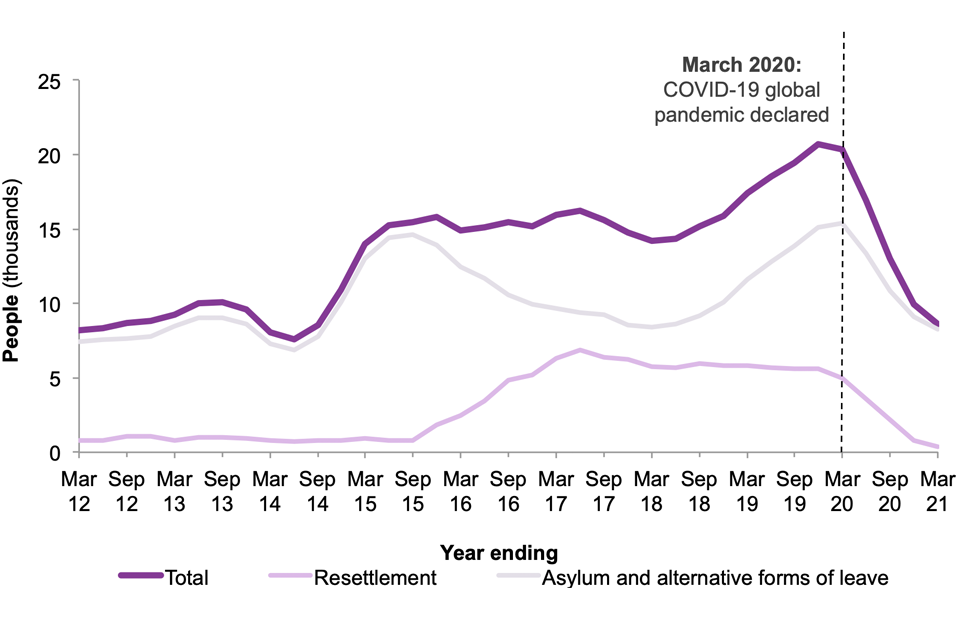
Source: Asylum applications, initial decisions and resettlement – Asy_D02
Notes:
- Grants at initial decision. Actual number of grants at final decision (following appeal) will be higher.
- ‘Alternative forms of leave’ include grants of humanitarian protection, discretionary leave, grants under family and private life rules, leave outside the rules and UASC leave, that resulted from an asylum application.
- Resettlement data prior to 2013 are only available annually. Data for individual quarters in this period have been estimated by taking 25% of the annual total.
- Includes main applicants and dependants.
Figure 1 shows that after 2017, there were increases in the total number of people granted protection, resettlement or other forms of leave; this number fell after March 2020, by 56% compared to the previous year (to 8,640 people). Grants following an asylum application were increasing from 2017 (8,564) rising to 15,363 in the year ending March 2020, since then they have decreased to 8,287, 46% fewer than the previous year. Resettlement has been fairly stable since 2016 but experienced a sharp reduction (down 93%) over the past year due to the pandemic.
In the year ending March 2020, prior to the COVID-19 pandemic, there were approximately 5,000 initial decisions made on asylum applications in each quarter. In the two quarters following the onset of the COVID-19 pandemic (Q2 and Q3 2020), the number of decisions made dropped, to approximately 2,700 per quarter. Although the number of decisions has increased in the latest two quarters, the numbers remain below levels seen before the pandemic (with 3,847 initial decisions in Q1 2021, 27% lower than in Q1 2020).
1.1 Resettlement
There were 353 people granted protection through resettlement schemes in the year ending March 2021, 93% fewer than in the previous year. Resettlement activity was paused in March 2020 following the beginning of the coronavirus pandemic, with no resettlement taking place between April and November 2020. Resettlement resumed in December 2020, with 345 people resettled in the first quarter of 2021.
In February 2021, the UK met its target to resettle 20,000 refugees under the Vulnerable Person Resettlement Scheme (VPRS). Following this, the government launched the new UK resettlement scheme (UKRS), bringing to an end the VPRS, Vulnerable Children Resettlement Scheme (VCRS), and the Gateway Scheme (see the user guide for further details). In its first month (March 2021), the UKRS resettled 25 refugees.
In the year ending March 2021, 73 of the 324 refugees resettled under the VPRS and VCRS, were resettled through Community Sponsorship. Since the VPRS and VCRS schemes ended, refugees resettled under Community Sponsorship are recorded separately to the other schemes – 4 people were resettled under the Community Sponsorship scheme in the month of March 2021.
Vulnerable Persons and Vulnerable Children’s Resettlement Schemes
The below provides a summary of the final number of refugees resettled in the UK under the VPRS and VCRS.
- 20,319 people were resettled under the VPRS between March 2014 and February 2021 (this includes 239 resettled before the scheme was upscaled and who were not included in the 20,000 commitment)
- 1,838 people were resettled under the VCRS between October 2016 and February 2021
- Of those resettled under the VPRS and VCRS, 522 were resettled through community sponsorship (484 under the VPRS, 38 under the VCRS).
Figure 2: Number of people resettled under the VPRS1 and VCRS2 from January 2014 to February 2021
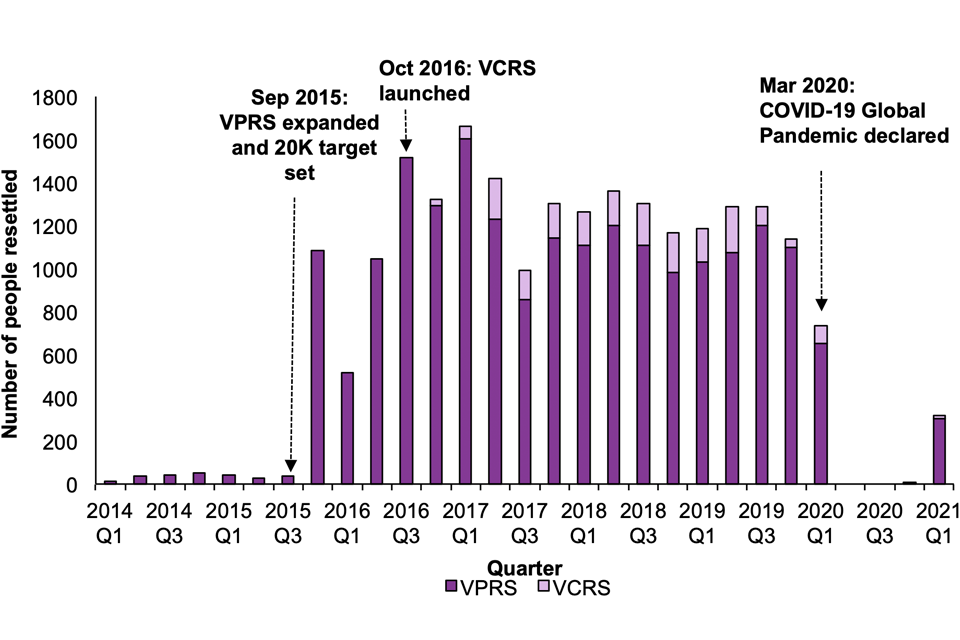
Source: Asylum applications, initial decisions and resettlement – Asy_D02
Notes:
- Vulnerable Person Resettlement Scheme aimed to resettle 20,000 people fleeing the Syrian conflict. Refugees resettled prior to the expansion of the scheme in September 2015 do not count towards the 20,000 target.
- Vulnerable Children Resettlement Scheme aimed to resettle up to 3,000 ‘at-risk’ refugee children from the Middle East and North Africa (MENA) region, including their families.
Figure 2 shows the number of refugees being resettled under the VPRS increased following the expansion of the scheme in September 2015, with typically over 1,000 refugees resettled per quarter. Numbers fell when the coronavirus pandemic was declared and resettlement activity was paused. Resettlement resumed again in December 2020, and the 20,000 target was reached in February 2021, bringing this scheme to an end, ahead of the introduction of a new scheme. VCRS intake makes up on average 10% of total refugees resettled under VPRS and VCRS.
When looking at the total resettlement activity under the VPRS and VCRS:
- Syria was the predominant nationality resettled under the VPRS, representing over 99% of the total (20,237). Prior to July 2017 the scheme only resettled Syrians, with small numbers of other nationalities coming since.
- Iraq was the top nationality resettled under the VCRS representing 46% of the total. This was followed by Sudanese nationals, which made up 26%.
- 49% of those resettled under VPRS were children and under VCRS 58% of the people resettled were children.
More information about the various schemes can be found in the ‘About the statistics’ section and the user guide.
2. Asylum applications
There were 26,903 asylum applications (relating to 32,411 people) in the UK in the year ending March 2021, around a quarter (24%) fewer than the previous year and similar to levels in 2017. This included 2,044 applications from Unaccompanied asylum seeking children (UASC), down 42% over the period. The latest figure will have been impacted by the measures taken in response to COVID-19 which have impacted migrants’ movements globally. Applications fell significantly in 2020 Q1, following the initial Covid-19 outbreak. Although they have increased since, they remain below levels seen prior to the outbreak (Q1 2021 saw 30% fewer applications than the same period in 2020).
Figure 3: Asylum applications lodged in the UK, years ending March 2012 to March 20211
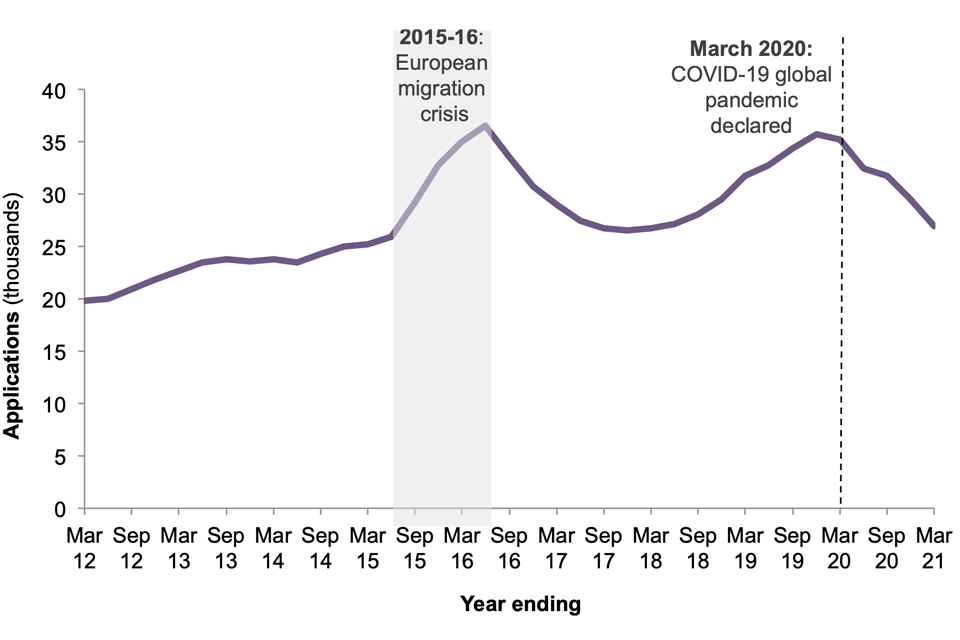
Source: Asylum applications, initial decisions and resettlement – Asy_D01
Notes:
- Includes main applicants only.
Figure 3 shows asylum applications rose steadily from 2012 to 2015, rising more rapidly during the European Migration crisis (2015-16), peaking in year ending June 2016. Applications fell after the crisis but increased again in 2018 reaching levels similar to the Migration crisis by the year ending March 2020. Applications fell again following the onset of the global pandemic.
Iran was the top nationality claiming asylum in the UK in the year ending March 2021, as it has been in every year since 2016 (3,523 applications, down 26% compared with the previous year), followed by Albania (2,840, down 19%).
Figure 4: Top 10 nationalities1 claiming asylum2 in the UK and grant rate3,4 at initial decision (%), years ending March 2020 and March 2021
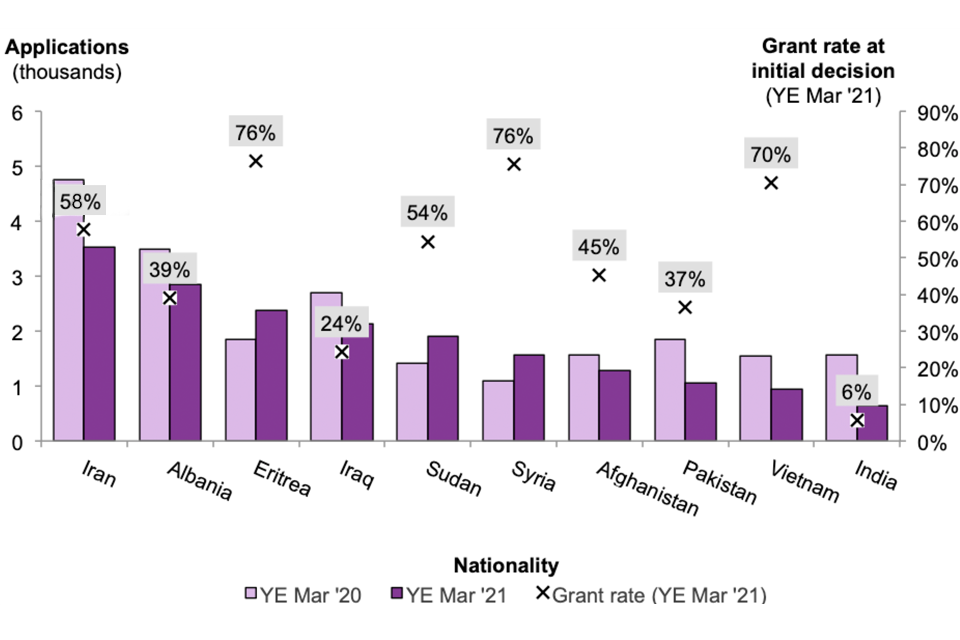
Source: Asylum applications, initial decisions and resettlement – Asy_D01 and Asy_D02
Notes:
- Top 10 nationalities in the most recent year (excluding Stateless).
- Includes main applicants only.
- The percentages in the chart are the grant rate at initial decision for each nationality in the most recent year.
- Grant rate is the proportion of initial decisions which resulted in a grant of protection or other leave. Grant rate is based on year of initial decision and is not directly comparable to applications, which are based on the date the asylum application was made.
Figure 4 shows the number of applications decreased for seven of the top ten nationalities applying for asylum in the UK. Of the top 10 nationalities, three experienced an increase – Eritrea (up 29%), Sudan (up 35%) and Syria (up 44%).
The fall in UK asylum applications was similar to the trends seen more widely across Europe. Comparing to the previous year, the total number of people (including dependants) claiming asylum in the EU+ (countries in the EU, EEA and Switzerland) decreased by 32% (Eurostat) and the UK decreased by 21% in 2020 (the latest period available for comparable statistics). Falls in applications were seen across most of the EU+ countries, including Greece (down 48%), France (down 38%) and Germany (down 26%); exceptions to this include Romania, Bulgaria, and Austria.
In 2020, the highest number of asylum applicants received in the EU+ were received by Germany (122,015 applicants) and France (93,475 applicants). In the same period, the UK received the 5th largest number of applicants (36,041) when compared with the EU+ member states, around 7% of the total asylum applicants in the EU+ and UK. This would represent only the 17th largest intake when measured per head of population.
Figure 5: The number of asylum applicants to the top five countries1 in the EU+ and the UK, between 2014-20202,3,4
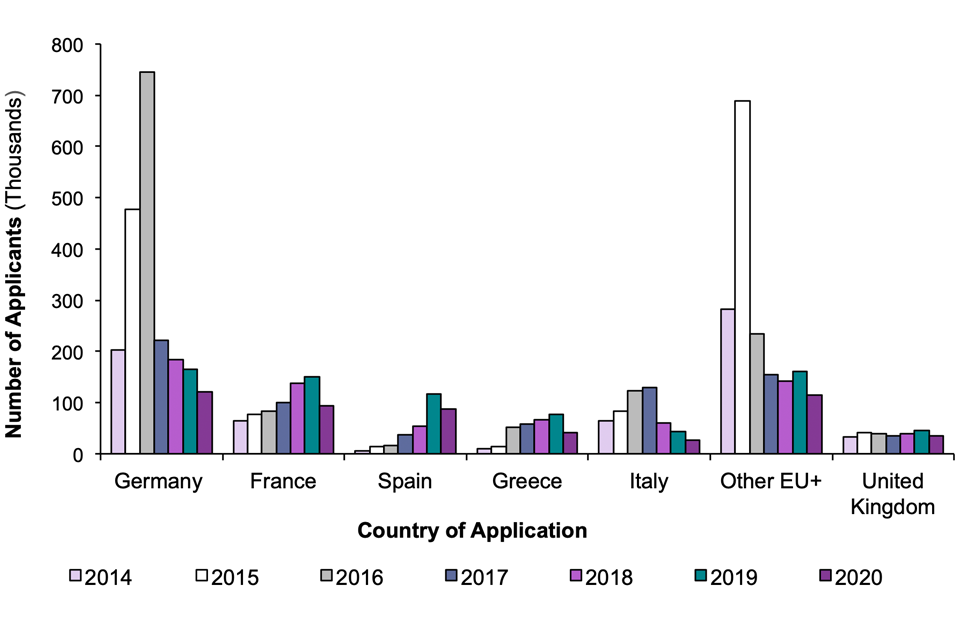
Source: Eurostat Asylum statistics
Notes:
- Top 5 countries in the EU+ receiving asylum applicants in the most recent year.
- Includes main applicants and dependants.
- The ‘Other EU+’ category includes all other countries that are European Union member states, part of the European Economic Area, and Switzerland.
- Data for the UK is sourced from Eurostat for years 2014-2019, and then Home Office data for 2020.
Figure 5 shows that while many countries in Europe had a substantial increase in asylum applications in 2015 and 2016 due to the European migration crisis, the UK experienced a smaller increase compared to other European countries. There is also a substantial drop in applications for all countries during 2020, when compared to 2019, due to COVID-19.
Please note that Eurostat data are not directly comparable with Home Office Immigration Statistics data, as set out in the immigration statistics user guide.
2.1 Grant rate
In the year ending March 2021, there were 12,968 initial decisions made on asylum applications, and almost half (48%) of these were grants of asylum, humanitarian protection or alternative forms of leave (such as discretionary leave or UASC leave), slightly lower than the previous year (54%), but higher than levels prior to 2019 when around a third of initial decisions were grants. The overall grant rate can vary for a number of reasons, including the protection needs of those who claim asylum in the UK, along with operational or policy decisions. Some initial decisions (mainly, but not entirely, refusals) will go on to be appealed. There were 3,663 appeals lodged on initial decisions in the year ending March 2021, of the appeals resolved over the period, 47% were allowed (meaning the applicant successfully overturned the initial decision).
Data from the Home Office ‘cohort’ analysis, published annually in Asy_D04, show that the final grant rate typically increases by 10 to 20 percentage points once the appeal stages are taken into account. For example, the grant rate for all applications for asylum made in 2016 to 2018 increased from 36% at initial decision, to 54% following appeal. More detailed analysis of the final outcome of asylum applications can be found in the year ending June 2020 edition of Immigration Statistics.
Grant rates vary considerably by nationality as the protection needs of specific groups or individuals differ, usually depending on the situation in their home country. Of those nationalities that commonly claim asylum in the UK, Libyans (93%) and Eritreans (76%) typically have high grant rates at initial decision, while nationals of India (6%) and Bangladesh (17%) have low grant rates.
3. Support provided to asylum seekers
At the end of March 2021, 44,825 asylum seekers who were awaiting the outcome of their asylum claim were in receipt of support under Section 95 of the Immigration and Asylum Act 1999, similar to the previous year (44,244).
An additional 6,122 individuals were in receipt of support under Section 4 of the Immigration and Asylum Act 1999, providing support where a claim has been rejected but the individual is temporarily unable to leave the UK, up 50% from the previous year (4,077).
There were 10,294 individuals in receipt of support under Section 98, nearly 3 times higher than the same time in the previous year (2,577). The sharp increase is likely related to COVID-19. For further information follow the link detailing the use of temporary hotels to house asylum seekers during COVID-19. Section 98 support is provided to asylum seekers on a short-term basis while their application for Section 95 support is considered.
4. Inadmissibility
From 1 January 2021, following the UK’s exit from the European Union (EU), the Dublin Regulation no longer applies to the UK. From this date, strengthened inadmissibility rules came into effect, which provide the basis for deeming an asylum claim inadmissible, where the claimant has earlier been present in or has a connection to a safe third country, and for returning the claimant to that or another safe country (with that country’s agreement). For further information on inadmissibility data, see the ‘about these statistics’ section.
In Q1 (January to March) 2021, 1,503 ‘notices of intent’ were served to individuals to inform them that their case was being reviewed in order to determine whether removal action on inadmissibility grounds was appropriate and possible. Over the quarter, there were no returns on inadmissibility grounds.
Table 1: Number of notices of intent issued under inadmissibility rules and subsequent returns.
| Jan-Mar 2021 | |
|---|---|
| Notices of intent issued1 | 1,503 |
| Returns | 0 |
Source: Management information, Home Office
Notes:
- ‘Notices of intent issued’ relate to the number of cases in which a notice was issued over the period.
5. About the statistics
This section provides information on those applying for and granted protection in the UK through both asylum and resettlement routes, as well as information on the numbers in receipt of asylum support.
The data are used to assess the trends in numbers of people seeking and being granted protection, the impact of policy changes, and to understand the demographics of those coming to the UK to claim protection. Data on resettlement and support, broken down by local authority, can help local authorities understand the demands on their services and resources to aid with planning.
The Home Office published an ‘Indicators of Integration framework’ in 2019, which provides a framework to support local and national practitioners in developing strategies and in measuring progress in the integration of refugees and other groups.
5.1 Asylum, resettlement and protection
The total number of individuals granted protection includes grants related to an asylum application (grants of asylum or alternative forms of leave) and resettlement. Alternative forms of leave include humanitarian protection, discretionary leave, UASC leave, leave outside the rules, and grants under family and private life rules. Further details can be found in the user guide.
Data on asylum applications relate to the period in which the application was lodged, and initial decisions relate to the period in which the decision was made. Initial decisions may, therefore, relate to an application made in an earlier period, and thus the two are not directly comparable.
Data on initial decisions will not reflect the total number of people granted protection through asylum routes as some initial decisions may be overturned following appeal. Data on the number of appeals lodged, and their outcomes, are published in Asylum appeals lodged and determined – Asy_D06 and Asy_D07.
UASC data includes those treated as an unaccompanied minor for at least one day between the date of application and the date of initial decision. Some UASC applicants may subsequently be found to be an adult following conclusion of an age dispute. Data on age disputes are published in Age Disputes – Asy_D05.
Eurostat asylum statistics can be used to compare asylum statistics with EU member states. The methodology used to compile Eurostat data differs from that used in this release. Further details can be found in the user guide.
The UK Community Sponsorship scheme was launched on 19 July 2016. The scheme allows community groups to support refugee families directly and aims to help them become self-sufficient and integrated members of the community.
Family reunion visas are a subset of the ‘Family – other’ visa category, published in the visa tables. The vast majority of ‘Family – other’ visas related to family reunion visas. Data on Family reunion visas come from a different administrative system to other visa data so are not directly comparable. Further details can be found in the user guide.
5.2 Support provided to asylum seekers
Figures for those in receipt of Section 95 and Section 4 support at the end of Q4 2020 have been taken from beginning of December (04/12/2020) rather than the end of month.
Section 95 support is provided to destitute asylum seekers until their claim is finally determined, which may encompass either accommodation or subsistence, or both.
Section 4 provides support for individuals whose claim has been refused and who have exhausted their appeal rights, but who are destitute and are temporarily unable to leave the UK.
Section 98 support provides accommodation for asylum seekers who would otherwise be destitute and who are either awaiting a decision on an application for Section 95 support or are supported under Section 95 and are awaiting transfer to their accommodation.
The data show the number of people in receipt of support on a given day, but do not show the length of time for which someone receives support or the amount of support they receive.
5.3 Inadmissibility
The inadmissibility rules provide the grounds for treating an asylum claim as inadmissible to the UK asylum system, if a person has earlier presence in, or connection to, a safe third country. It also provides for the person to be removed to that or another safe third country, with that country’s permission. Prior to the UK leaving the EU, the Dublin Regulation established the criteria and mechanisms for determining which state was responsible for examining an application for international protection. Strengthened inadmissibility rules came into effect on 1 January 2021, following the UK’s departure from the EU.
If there is sufficient evidence that an asylum claimant may be eligible for return under inadmissibility principles, they may be issued with a ‘notice of intent’. This informs the claimant how their case is being managed. It does not constitute a formal decision.
The Home Office will seek agreement to return the applicant. If the case meets the inadmissibility requirements, and another country accepts the applicant’s return, the Home Office will treat the asylum application as inadmissible under the inadmissibility rules and arrange the return. If there is insufficient evidence to meet the requirements of the inadmissibility rules or another country has not accepted responsibility for the claim within a reasonable timescale then the asylum claim will be fully considered in the UK.
The data relate to the number of notices of intent issued, and the number of returns under inadmissibility rules.
Data on inadmissibility are taken from internal Home Office management information and should be considered provisional.
Prior to the UK leaving the EU, data on transfers into and out of the UK under the Dublin Regulation were published in Dub_D01.
6. Data tables
Data referred to here can be found in the following tables:
Additional data relating to asylum, protection and resettlement published in earlier Immigration Statistics releases include:
Statistics on the number of applications and decisions of those applying to enter or remain in the UK under the new Hong Kong British Nationals (Overseas) route are included in the ‘How many people come to the UK each year (including visitors)?’ section.
We welcome your feedback
If you have any comments or suggestions for the development of this report, please provide feedback by emailing MigrationStatsEnquiries@homeoffice.gov.uk. Please include the words ‘PUBLICATION FEEDBACK’ in the subject of your email.
We’re always looking to improve the accessibility of our documents. If you find any problems or have any feedback relating to accessibility, please email us.
See section 7 of the ‘About this release’ section for more details.
